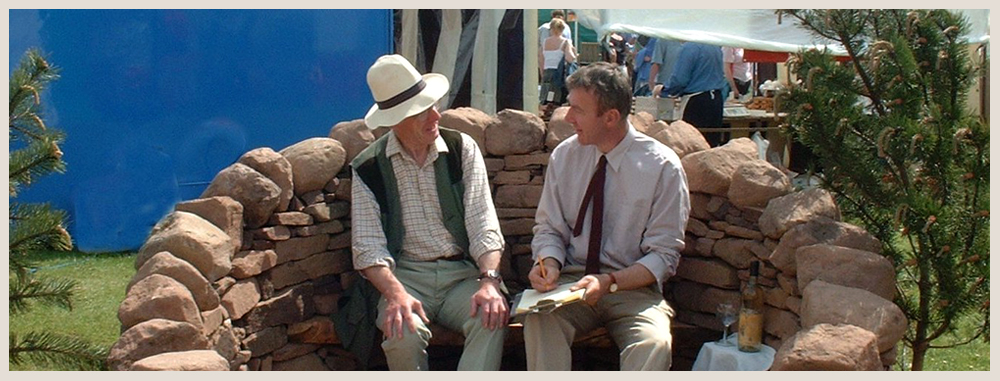The following article was written by Andrew McIntyre and published in the SCOTS Magazine in November 2009.
Nigel Bialy…
When we were youngsters, my two older brothers and I loved nothing more than to play around with rocks and boulders. We whiled away many a long summer’s day on the River Orchy near Dalmally, building cairns and attempting to dam tributaries into which (we fancied) we could lure a few plump trout. Broken down dykes and sheep fanks provoked special excitement. We would swarm over them with sleeves rolled up and muscles straining as we pulled on loose stones, and heaved the bigger foundation boulders back into perfect alignment.
There was however a flaw in our technique, for our constructions seldom proved more durable than a card house. We had learned by experience that our critical height was about three feet, above which there was a sudden fatal tendency for our handiwork to collapse into a ruckle of untidy stones pretty similar to what we’d found in the first place. I suspect our enjoyment came in equal measure from both the building and the inevitable collapse. Either way, we left no durable monuments I could take you back to today.
* * *
Nigel Bialy’s interest in stone work began when he was gaining practical experience on a farm while studying for a degree in Agriculture at Aberdeen University. During an idle moment he de-constructed a damaged dyke to examine how it had been put together. He found it consisted of two side walls spaced apart at the base but brought together at the top in an “A” shape. Long ‘tie’ stones were used to weave the two walls together at different heights and all gaps were filled up with rubble before the top was closed off with cope-stones.
Armed with this information, he got busy and managed to restore a long run of bulging and capsized dyke to pristine condition. The work was hard but unexpectedly satisfying. Before you can build anything in stone you have to sort through piles of the stuff selecting shapes that will ‘hold’ together well, and working with any media in three dimensions presents challenges that can only be overcome through trial and error. But once you acquire the basic skills, the creative possibilities of working in stone become almost unlimited – and it was this aspect that excited Nigel most as he laid his final copestone and stepped back to survey his handiwork.
Back at university there were exams to be taken and further career decisions to be made. After graduating from Aberdeen Nigel went on to take a Masters in Land Economy. His qualifications opened the door to a variety of jobs including a trip to New Zealand as a shepherd, and spells as a farm manager in Morayshire and as a land agent with Scottish National Heritage – together with a variety of consultancy projects.
But alongside a fairly orthodox career path, Nigel was devoting more and more time to his real passion – designing and constructing dry-stone structures in a variety of landscapes. Word soon spread that an ‘artist in stone’ had arrived on the scene, prompting an upsurge in demand. With an order book now placing a heavy demand on his time, Nigel realised he had reached a cross-roads in his life. He would have to choose between a relatively secure salaried career in agriculture – or turn what had become a profitable hobby into a full-time job.
Evidently his creative side won out for he was soon dividing his time between his drawing office and a multitude of sites he had become involved with around the country.
His first major contract took him to Camis Eskan House in Helensburgh where he constructed a heavy stone buttress and rebuilt the parapet walls of a stone bridge. The lead contractor was a Glasgow based civil engineering group whose demands for heavy technical reports might have daunted lesser mortals but fortunately Nigel’s professional training as a Land Agent proved an invaluable asset.
Further work flowed in, taking him to Mull, Orkney & Shetland, the Borders – and many stations in between.
In 2000 Nigel booked his first stand at the Royal Highland Show. “I had no idea how to market myself at that stage” he recalls with some embarrassment “and the information I handed out to enquirers was pretty basic by any standards”. Yet he learned much from the experience and returned to Ingleston the following year with a fresh, eye-catching design and an illustrated colour brochure. The response from visitors all over the country was extremely encouraging and did much to secure the future of the fledgling business.
* * *
Designing and implementing something in stone are two different things.
First and most crucially, you have to source the stone which is no easy thing given that the law now prohibits old dykes from being ransacked for their materials. Quarried rock may be available but is generally unsuited to dry-stone feature work because it looks “new” and has sharp angular edges. It may also be flawed and inclined to shatter suddenly due to blast-stress.
So Nigel collects virtually all of the stone he uses from three local farms near his home in Comrie. “The process is highly selective – I look for stones that will work together well in terms of size, shape and weathering.” Most are brought to the surface by ploughs and have a variety of interesting shapes as well as being pleasantly weathered. It may seem eccentric to truck stone from Perthshire to distant sites, but Nigel reckons it’s the best way. “The last thing I need when I start a new project far from home is to spend the first several days hunting for stone and contractors who are prepared to truck it to where I want it” he says.
Having sorted and assembled the stone on-site, construction can begin. But although detailed drawings can be produced on paper, things always look different once you get on site. “Every structure has to ‘fit’ within the landscape it occupies” says Nigel – and this isn’t something you can delegate to on-site workers, however great their technical skills. I need to be present and I need to re-interpret my drawing continuously as the project moves forward”. The demand for an artist’s eye to be present throughout the whole process will always limit Nigel’s operation – unless he can recruit others who share his aesthetic ‘feel’ for the work. He is in no hurry to do so though since growing the business would inevitably distance him from the ‘front-line’ which is where he wants to be.
* * *
The variety of Nigel’s work continues to grow. He has built several arch bridges, potting-sheds and bothies. He has also developed an extensive range of garden features many of which incorporate seats for relaxation and are well illustrated in him current brochure. His greatest joy is to create something distinctive “that looks as if it has been there for hundreds of years”. Just add lichen!
* * *
A few years back, the luckiest rabbit alive was delivered to the Ingleston Showground (Edinburgh) on a tipper truck. The truck reversed up to Nigel’s stand and allowed its 10 tonne payload of heavy boulders to crash to the ground , out of which popped an unscathed baby rabbit. “The astonishing thing” says Nigel “is that the rabbit must have been amongst the rocks when they were loaded by JCB the night before!”
Over the next several hours the new arrival nibbled grass and watched Nigel’s efforts with evident approval as he laboured to built up his dry-stone display. It then adopted the stand as ‘home’ for a couple of days before hopping off to explore greener pastures.
Fortunately its antics drew a steady stream of curious by-standers – some of whom stayed on to admire Nigel’s artfully constructed display. Who could resist the comfortable seat, the welcome shelter from a biting east wind, and even the prospect of a glass of wine?!

